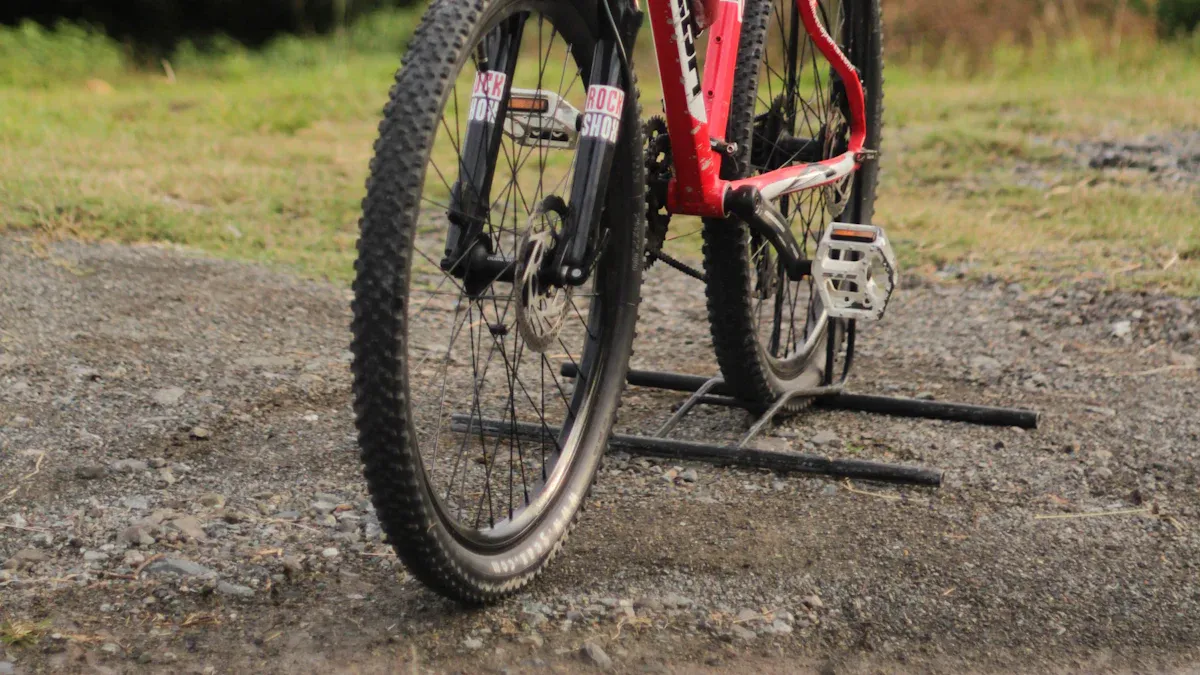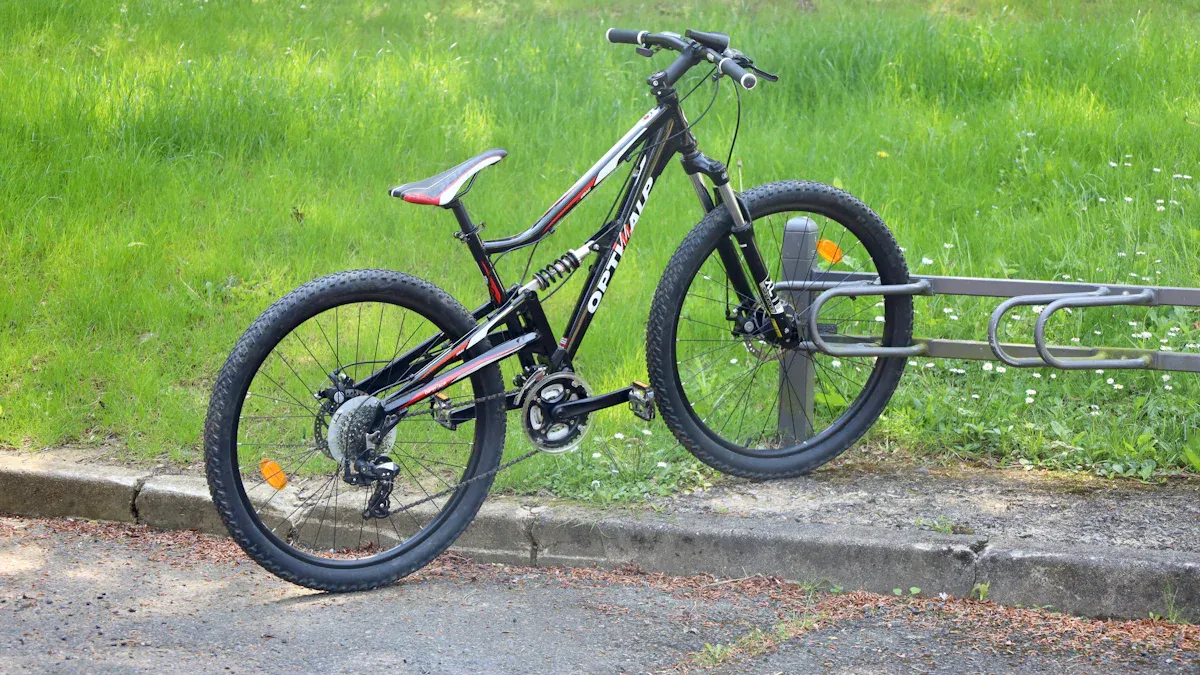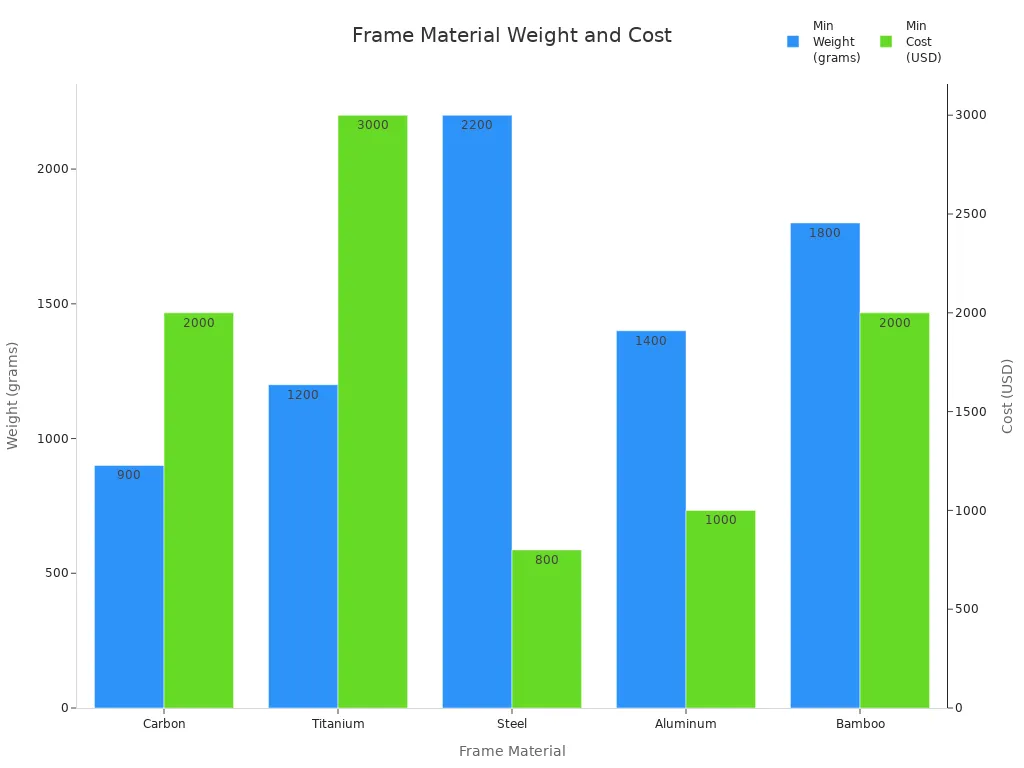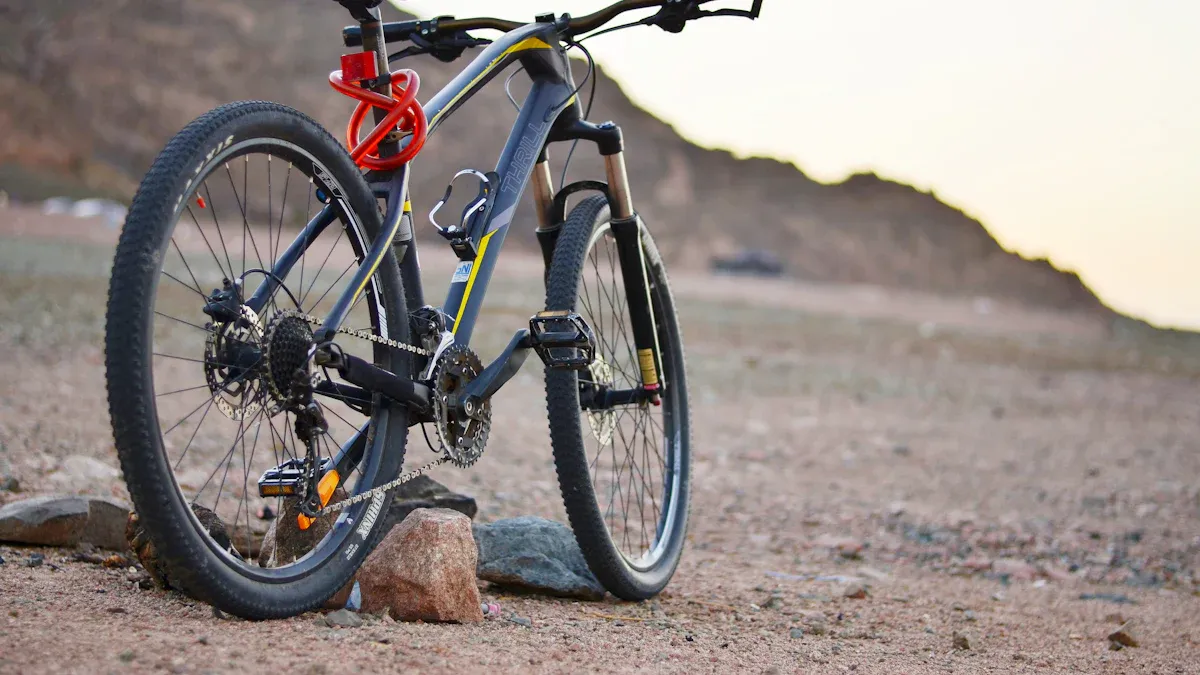
When you look at mountain bike frames hardtail and full suspension, you see two main types. Mountain bike frames hardtail have suspension only in the front fork, while full suspension bikes have suspension in both the front and back. Your choice changes how you feel on the trail. Full suspension bikes help you feel less tired by soaking up bumps and shakes on rough paths. Mountain bike frames hardtail let you feel the trail more directly, which some riders prefer for climbing and smooth trails. The frame material and design of mountain bike frames hardtail can change how stable you feel and also affect your comfort. New suspension systems and frame shapes help you control the bike better, giving you more grip and making you feel more confident when riding.
Key Takeaways
Hardtail mountain bikes have front suspension only. They are lighter and simpler. They are easier to take care of. They work well on smooth trails. They are good for cross-country rides.
Full suspension bikes have front and rear suspension. They give you more comfort and control. They help you grip better on rough trails. They work well on rocky or steep paths. They need more care and cost more money.
Pick a hardtail if you want a fast bike. It is good for climbing and smooth paths. It costs less and needs less work.
Choose a full suspension bike for tough trails. It helps you feel less tired. It keeps you safer with better shock absorption.
Think about your riding style and the terrain. Look at your budget and how the bike fits your body. Try riding both types to find the best mountain bike for you.
Hardtail vs Full Suspension

What Is a Hardtail Mountain Bike?
You often see hardtail mountain bikes on trails and races. A hardtail bike has suspension only in the front fork. The back part of the frame does not move. This makes you feel the bumps and dips more. You can pedal hard and go fast on smooth paths. Hardtail bikes are lighter than full suspension bikes. They have fewer parts that can break. You do not need to fix them as much. Many people pick hardtail bikes for cross-country rides. They want a bike that is fast and simple. Hardtail bikes also cost less money. You can buy better parts for the same price.
What Is a Full Suspension Mountain Bike?
Full suspension mountain bikes have suspension in the front and back. There is a front fork and a rear shock absorber. The back part of the frame moves with special joints. This helps you ride over rocks and roots more easily. Full suspension bikes soak up bumps and keep you comfortable. You do not get as tired on long rides. These bikes give you better grip and balance on tricky trails. Full suspension bikes are heavier because they have more parts. You need to check and fix the suspension more often. Riders who like rough trails or downhill rides often choose full suspension bikes. They want more grip and to feel safer.
Key Differences
You may wonder how hardtail and full suspension bikes are different. Here is a table that shows the main differences:
Feature | Hardtail Frame | Full Suspension Frame |
|---|---|---|
Suspension Components | Front suspension fork only | Front suspension fork plus rear shock absorber |
Rear Triangle | Rigid, non-moving | Connected via pivots and linkages allowing movement |
Weight | Lighter due to simpler design | Heavier due to added rear suspension system |
Complexity | Mechanically simpler | More complex with additional moving parts |
Ride Characteristics | Efficient power transfer, less forgiving on rough terrain | Increased comfort, traction, and control on rough terrain |
Maintenance | Lower maintenance requirements | Requires more maintenance due to rear suspension |
Budget Implications | Better components for the price | Rear suspension costs may reduce component quality at same price point |
Hardtail bikes are lighter than full suspension bikes. Most hardtail bikes weigh about 26 to 28 pounds. Full suspension bikes usually weigh 30 to 34 pounds. Lighter bikes are easier to pedal uphill and start quickly. Full suspension bikes are heavier but give you more comfort and control.
Hardtail bikes are best for smooth trails and racing. You feel the ground and learn new skills. Full suspension bikes are better for rough trails. You do not get as tired and stay in control over rocks.
Here are some quick points to help you compare hardtail and full suspension mountain bikes:
Hardtail bikes have only front suspension, so they are lighter and easier to use.
Full suspension bikes have both front and rear suspension for more comfort and control.
Hardtail bikes cost less and need less fixing.
Full suspension bikes are better for rough trails but need more care and money.
Hardtail bikes are good for cross-country and smooth trails.
Full suspension bikes work best on rocky, steep, and tricky trails.
Think about how you ride, where you ride, and how much you want to spend before you choose a hardtail or full suspension mountain bike.
Mountain Bike Frames Hardtail
Features
When you pick mountain bike frames hardtail, the back part does not move. The front fork has suspension, but the rear triangle is stiff. This makes hardtail mtb lighter than full suspension bikes. Hardtail mtb send your pedaling power straight to the back wheel. You can speed up fast and ride quickly on smooth trails. Hardtail mtb frames have fewer moving parts, so you do not need to fix them as much. Many people like hardtail mtb because they cost less, so you can buy better parts for the same money. Most hardtail mtb are made from carbon fiber, aluminum, steel, titanium, or bamboo. Each material changes how your hardtail bike feels and works.
Material | Weight | Strength | Stiffness | Durability/Repairability | Cost Effectiveness | Ride Comfort/Compliance | Corrosion Resistance | Fatigue Life |
|---|---|---|---|---|---|---|---|---|
Aluminum | Lightweight | Moderate to High | High | Difficult to repair | Cost-effective | Less comfortable | Corrosion resistant | Shorter fatigue life |
Steel | Heavier | Very High | Moderate | Easily repaired | Inexpensive | Good compliance | Prone to rust | Highly resistant |
Titanium | Light | Very High | Moderate | Easily repaired | Expensive | Good compliance | Corrosion resistant | Excellent |
Carbon Fiber | Very light | High | Very High | Fragile under impact | Expensive | Low elasticity | Corrosion resistant | Variable, can crack |
Bamboo/BioMid Fiber™ | Moderate | Moderate to High | Moderate | Variable | High cost | Good vibration damping | Environmentally friendly | Moderate |

Pros and Cons
Tip: Hardtail mtb are good for new riders who want a simple bike to learn and get better.
Pros of hardtail mountain bike frames:
Hardtail mtb are lighter, so you can move them easily.
You climb better because all your power goes to the back wheel.
These bikes help you learn skills by letting you feel the trail.
Hardtail mtb are simple to carry and store.
Cons of hardtail mountain bike frames:
You feel more bumps, which can be hard if your back hurts.
Hardtail mtb are not great for very steep or tricky trails.
You can only change the front suspension, not the back.
Best Use Cases
Hardtail mtb are best for smooth trails, cross-country rides, and easy paths. Mountain bike frames hardtail work well on forest roads, gravel, and neat trails. Hardtail mtb are good for beginners and riders who want to go fast, climb, and get better at riding. If you ride on flat or rolling ground, a hardtail bike is fun and quick. Hardtail mountain bikes are also good for people who ride to work or want a light bike for exercise.
Full Suspension Mountain Bike

Features
A full suspension mountain bike has suspension in the front and back. The frame uses a rear shock absorber and a front fork. Both wheels move up and down to handle bumps. This makes your ride smoother and helps you control the bike better on rocky trails. A full suspension mtb is heavier than a hardtail because it has more parts. The frame has pivots and linkages that let the rear suspension move. You get more grip and comfort, especially on steep mountain trails.
Here is a table that compares a full suspension mountain bike to a hardtail:
Feature | Hardtail Mountain Bike | Full Suspension Mountain Bike |
|---|---|---|
Suspension | Front suspension only (no rear suspension) | Both front and rear suspension |
Weight | Lighter due to simpler design and fewer parts | Heavier because of added rear suspension components |
Maintenance | Easier and less expensive to maintain | More complex, requires more maintenance |
Cost | Generally cheaper | More expensive due to complexity and parts |
Trail Suitability | Best for smoother trails | Ideal for technical, rough, and challenging trails |
Comfort | Less comfortable on rough terrain | More comfortable due to better shock absorption |
Control & Traction | Good on moderate terrain | Better control and traction on technical terrain |
A good full suspension bike lets you change how it rides. You can adjust the head tube angle or bottom bracket height. Most full suspension mtb frames have 140–170mm of suspension travel. This helps you ride down steep hills and over rocks. The suspension keeps your wheels on the ground, so you stay in control.
Pros and Cons
Note: A full suspension mtb gives you more comfort and control, but you need to care for it more often.
Pros:
A full suspension bike makes your ride smoother by soaking up bumps.
The rear suspension helps your back wheel stay on the ground for better grip.
You feel less tired after long rides because the suspension absorbs shakes.
Full suspension mtb bikes help you go faster and safer on tough trails.
You feel braver when riding downhill or on rough ground.
Cons:
The suspension system is more complicated, so you need to check and fix it more.
Cleaning a full suspension bike takes longer because of extra parts.
Some riders lose power if the rear suspension does not work well.
The frame is less stiff because of the pivots and joints, which adds weight.
Best Use Cases
Pick a full suspension mountain bike if you ride on rocky or steep trails. Full suspension mtb bikes are best for downhill, enduro, and all-mountain riding. Riders who want to go down tough hills or ride on rough ground like full suspension mtb. These bikes are also good for trail riding, where you need to climb and go down hills.

Full suspension mtb bikes are great for riders who want more comfort and control. If you ride on hard mountain trails or want to try new things, a full suspension bike will help you stay safe and have fun.
Comparison
Comfort and Control
When you ride on rough mountain trails, comfort and control matter most. Full suspension bikes give you a smoother ride by absorbing bumps from rocks and roots. This helps you stay in control and feel less tired, especially on long or technical trails. You can ride longer and faster with less fatigue. Hardtail bikes only have front suspension, so you feel more of the trail. On smooth trails, a hardtail bike works well and feels direct. On rocky ground, you may feel every bump, which can make you tired faster. Full suspension bikes keep your wheels on the ground, giving you better grip and stability.
Full suspension absorbs more shocks, making rough trails easier.
Hardtail bikes are lighter and give you a direct feel but are less comfortable on bumpy terrain.
Full suspension helps you ride with more confidence on technical trails.
Weight and Efficiency
Hardtail bikes weigh less because they have fewer suspension parts. This makes them easier to carry and faster on climbs. The stiff frame of a hardtail bike means more of your energy goes straight to the wheels, which boosts performance on cross-country rides. Full suspension bikes are heavier, but the extra weight gives you more comfort and control on rough trails. Some riders find that full suspension bikes feel slower on smooth climbs, but they perform better on technical descents.
Tip: If you want to go faster on climbs or race cross-country, a hardtail bike gives you the best efficiency.
Maintenance and Cost
Hardtail bikes have a simple design. You spend less time and money on maintenance because there are fewer moving parts. Full suspension bikes need regular checks on both the front and rear suspension. You must clean and service the rear shock and pivots often, especially after muddy rides. Over time, full suspension bikes cost more to own because of these extra parts. Hardtail bikes are more reliable and cost-effective for long-term use.
Feature | Hardtail | Full Suspension |
|---|---|---|
Maintenance | Low | High |
Long-term Cost | Lower | Higher |
Reliability | High | Moderate |
Terrain and Riding Style
Your choice depends on where and how you ride. Hardtail bikes shine on smooth trails, forest paths, and cross-country courses. They give you quick acceleration and great performance on less technical terrain. Full suspension bikes work best on rocky, steep, or technical trails. If you like downhill riding or need more comfort, full suspension is the better choice. Riders who want a simple, efficient bike for cross-country or daily rides often pick a hardtail. If you ride rough mountain trails or want more control, choose full suspension.
Hardtail Bike | Full Suspension Bike | |
|---|---|---|
Cross-country | Efficient, lightweight, simple | Comfortable, better for rougher courses |
Trail Riding | Best on smooth or rolling trails | Best on technical, rocky, or steep trails |
Downhill/Enduro | Not ideal | Essential for control and comfort |
Hardtail or Full Suspension: How to Choose
Assess Your Needs
Choosing between hardtail or full suspension can feel overwhelming, but you can make the right decision by looking at your needs. Start by thinking about your riding style. Do you enjoy smooth trails, or do you want to tackle rocky mountain paths? If you like fast rides on gentle ground, a hardtail or full suspension may not matter as much, but hardtails often shine here. If you plan to ride on rough, technical terrain, a full suspension bike gives you more comfort and control.
Your body measurements play a big role in picking the right mountain bike. Check your height, inseam, torso length, arm length, and shoulder width. These measurements help you find a frame that fits well. Frame geometry matters too. Look at the stack and reach, head tube angle, seat tube angle, chain stay length, and wheelbase. These features change how the bike handles and feels. For example, a higher stack gives you a more upright position, while a longer reach adds stability. A steeper head tube angle helps with sharp turns, while a slacker angle makes downhill rides smoother.
Think about the frame material. Aluminum, carbon fiber, steel, and titanium all affect the weight, durability, and cost of your mountain bike. Your seating position also matters. Some riders prefer an upright position for long rides, while others want a more aggressive stance for downhill or freeride biking. Always check the size charts from the manufacturer, but remember that personal comfort and riding goals are just as important. Avoid choosing a frame just because it is available. A poor fit can cause discomfort and even injury.
Budget is another key factor when deciding between hardtail or full suspension. Hardtail bikes usually cost less because they have a simpler design. You can often get better components for the same price. Full suspension bikes cost more due to the extra parts and complexity. Maintenance costs also differ. Hardtails need less upkeep, while full suspension bikes require regular checks on the rear shock and pivots. If you want a cost-effective and simple mountain bike, a hardtail may suit you best. If you are willing to spend more for comfort and performance, a full suspension bike could be the right choice.
Tip: Test rides and professional fitting services help you find the best mountain bike for your body and riding style. Never skip this step.
Tips for Deciding
You can use a few simple steps to decide between hardtail or full suspension. Start by listing your main riding goals. Do you want to race, explore mountain trails, or ride for fun? Next, match your goals to the type of bike. Hardtail bikes work well for cross-country, smooth trails, and riders who want a lighter, simpler option. Full suspension bikes are better for rough, steep, or technical mountain terrain.
Here is a table to help you compare the two options:
Aspect | Hardtail Mountain Bike | Full Suspension Mountain Bike |
|---|---|---|
Suspension | Front fork only | Front fork and rear shock |
Main Advantage | Efficiency, simplicity | Comfort, traction, control |
Main Drawback | Harsher ride on rough terrain | Heavier, more maintenance |
Budget Consideration | Better parts for the price | More spent on suspension system |
Test ride both hardtail or full suspension bikes before you buy. This lets you feel the difference in comfort, handling, and fit.
Ask for advice from bike shop experts. They can help you match your mountain bike to your needs and body size.
Think about long-term costs. Hardtail bikes save money on maintenance, while full suspension bikes need more care.
Check the wheel size. A 27.5″ wheel gives you more agility, while a 29″ wheel rolls over obstacles better.
Look at your local trails. If you ride mostly on smooth paths, a hardtail may be perfect. If your trails are rocky or steep, a full suspension bike will help you stay in control.
Note: Trying both types of bikes helps you find what feels best. You gain confidence and enjoy your rides more when you pick the right mountain bike.
When you weigh your riding style, terrain, budget, and maintenance preferences, you can choose the best hardtail or full suspension mountain bike for your adventures. Take your time, ask questions, and always test ride before you decide.
You now know the main differences between hardtail and full suspension mountain bike frames. When you choose a mountain bike, think about your riding style, the terrain, and your budget. Each mountain bike offers unique benefits. Hardtail bikes work well for smooth mountain trails. Full suspension bikes help you handle rough mountain paths.
Try both types of mountain bike if you can. Ask a local expert for advice before you buy your next suspension mountain bike.
FAQ
What type of mountain bike is best for beginners?
You may find hardtail bikes easier to start with. They cost less, weigh less, and need less care. You can learn basic skills quickly on a hardtail. Many new riders choose hardtails for their first mountain bike.
Can you use a hardtail bike on rough trails?
You can ride a hardtail on rough trails, but you will feel more bumps. Full suspension bikes handle rocks and roots better. If you ride rough trails often, you may want the extra comfort and control from full suspension.
How often should you service a full suspension bike?
You should check your full suspension bike after every few rides. Clean the suspension parts and look for wear. Most riders service the rear shock and pivots every few months. Regular care keeps your bike safe and smooth.
Is a full suspension bike worth the extra cost?
A full suspension bike gives you more comfort and control on tough trails. If you ride rocky or steep paths, the extra cost can be worth it. You may enjoy longer rides and feel less tired with full suspension.
See Also
Choosing Between Hardtail And Full Suspension Mountain Bikes
A Guide To Selecting The Perfect Bike Frame For You
Professional Tips For Picking The Best Carbon Bike Frame
Differences Between Fat Bike And Mountain Bike Frames Explained
Understanding Full Suspension Bike Frames And Their Functionality
